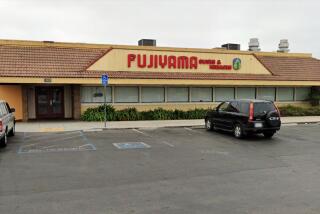‘Fruit’ in that juice? It could be red dye
- Share via
About half of the most aggressively marketed children’s food with pictures or names of fruit on the packaging contains no fruit at all, according to a report to be released today at the 2007 California Childhood Obesity Conference in Anaheim.
Some of the least fruity products were cereal and yogurt, said lead author Leslie Mikkelsen, a dietitian for Prevention Institute, an Oakland-based nonprofit that promotes community-based health and safety programs.
She pointed to a box of Berry Berry Kix that showed a big spoonful of cereal with what at least looked like raspberries and blueberries.
“Parents do think cereals are a good way to start the day,” Mikkelsen said, and they look at this one and think “it has the goodness of fruit.”
But in fact, said Mikkelsen, pointing to the ingredients listed on the box, “all that’s in there is red dye and blue dye.”
Similarly, Yoplait Go-Gurt Strawberry Splash yogurt contained no strawberries. General Mills, the maker of both the cereal and the yogurt, declined to comment, saying the company had not seen the report.
Of the 37 products examined, 19 contained no fruit ingredients and six had only minimal amounts of fruit juice. Two contained 100% fruit juice, and 10 contained actual whole fruits, which have less sugar and more fiber and nutrients than juice alone.
“Today’s parents are looking for healthier products for their children, but the food industry isn’t making it easy for them,” Mikkelsen said.
The six-page report, “Where’s the Juice? Fruit Content of the Most Highly Advertised Children’s Food and Beverages,” was sponsored by the Strategic Alliance for Health Food and Activity Environments, a statewide coalition of public health and nutrition organizations. It comes amid growing concern about rising rates of obesity in children and adolescents, and a related surge in Type 2 diabetes.
Based on the 2004 California Physical Fitness Test, which is administered in public schools to fifth-, seventh- and ninth-graders, one study showed that the proportion of overweight children climbed to 28.1%, up from 26.5% in 2001.
As a result of these increases, the marketing of nonnutritious foods, their accessibility on school campuses and their content -- such as sugar and trans fats -- also are coming under closer scrutiny and regulation.
For this report, the researchers used data from a recent Kaiser Family Foundation study to identify the top-spending food advertisers on children’s television programs.
The report excluded fast-food advertisers and concentrated on 37 items that could be bought in grocery stores and that showed pictures of fruit or used the words “fruit” or “fruity” on the packaging.
Children’s marketing heavily emphasizes candy and sodas, and some of the products found to contain no fruit -- such as Juicy Fruit gum and Wild Cherry Life Savers -- were hardly surprising. Indeed, Mikkelsen said she was surprised to find that Popsicles and Skittles actually did contain a small amount of fruit juice.
But, she said, parents have different expectations of fruit “flavored” drinks, which often contain less than 10% juice.
“I really don’t think a lay person knows that fruit drink doesn’t mean fruit juice, especially if it has these beautiful pictures of fruit on it,” she said.
Rosa Soto of Whittier, the mother of an 8-year-old son, agreed.
“A lot of parents think they can trust the labels,” she said, meaning the colorful picture of an apple or orange, not the small-print ingredients that manufacturers are required to list.
Soto volunteers as a “team mom” for her son’s football, basketball and baseball teams, and encourages other parents to bring water to their children’s practice sessions and games. Many show up with fruit drinks that contain more sugar than nutrients.
“They’re trying their very best to provide healthy snacks,” she said.
Even drinks that contain 100% juice don’t match the fiber and nutrients of whole fruit, said Mikkelsen, and are highly concentrated sources of fructose, a sugar. The American Academy of Pediatrics and federal dietary guidelines recommend that children eat whole fruits and limit fruit juice to 4 to 12 ounces per day.
The three-day California Childhood Obesity Conference drew more than 1,700 health advocates and officials to Anaheim.
Rising obesity levels in California and the nation are attributed to increased consumption of sweetened beverages; reliance on meals that are high in fat and low in fruits, vegetables and whole grains; reduced physical activity; and unsafe neighborhood play areas.
*
*
Begin text of infobox
Fruitless
A study found that many child-oriented foods in packages that depict fruit contained no fruit at all.
Fruit content
No fruit -- 51%
Fruit -- 27%
10% or less fruit juice -- 16 %
100% fruit juice -- 6%
*
Source: Prevention Institute
More to Read
Inside the business of entertainment
The Wide Shot brings you news, analysis and insights on everything from streaming wars to production — and what it all means for the future.
You may occasionally receive promotional content from the Los Angeles Times.










